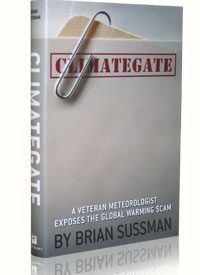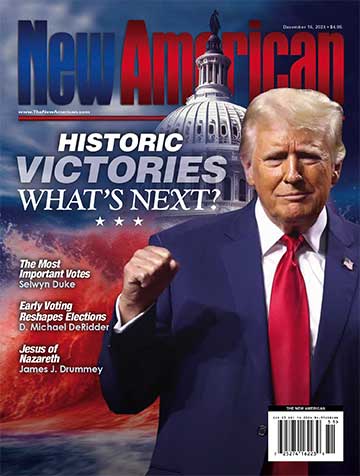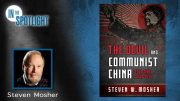
Climategate: A Veteran Meteorologist Exposes the Global Warming Scam, by Brian Sussman, Washington, D.C.: World Net Daily, 2010, 224 pages, hardcover.Gideons International should obtain rights to this title and place a copy in every hotel room in the United States. It is a veritable bible arming readers with information they need to refute the claims of environmentalists that humans can adversely influence climate.
Americans need to understand this issue, because devastating public policy is being crafted based on faulty science cooked up by those who stand to make a lot of money off the hoax.
Readers of The New American in San Francisco will recognize the author, Brian Sussman. He is an award-winning science reporter and meteorologist and hosts a top-rated talk radio program in the Bay area. He has more than 20 years’ experience in climate science and is dedicated to refuting the claims of those who promote the idea of anthropogenic (human-caused) global warming (AGW).
As the title indicates, Sussman’s book tells the story of Climategate, the incident of November 2009 in which hackers pirated hundreds of e-mails from a British university. The correspondence revealed that top UN climate scientists from around the world had for more than a decade been fraudulently reporting data to favor their alarmist climate agenda.
Science
However, Sussman’s book does not stop there. In fact, he began writing it more than two years ago. As he was wrapping up the final version, Climategate broke, and he redrafted the entire work, incorporating important highlights of the scandal along with background information about the perpetrators. Evidence from these e-mails significantly reinforces many of the points Sussman makes in his exposé of fabricated climate science.
For example, he gives a brief explanation of the cyclical nature of climate, citing the Medieval Warm Period (MWP) when global temperatures were considerably higher than those of the present day, and the subsequent Little Ice Age (LIA), during which once-fertile Greenland became buried under ice. He shows how proof of global climate fluctuations is based on physical evidence and historical observations. More importantly, he reveals — from both personal experience and Climategate e-mails — a concerted media coverup of the truth.
There are many other climate myths that Sussman debunks in his page-turning book. For example, it is a common media-inspired misconception that the United States is withering under its hottest weather in history. Sussman reports on the shockingly large number of official U.S. weather monitoring stations compromised by increasing urbanization in their immediate vicinities. The results of these and other setting violations are false recordings significantly higher than actual surface temperatures. Additionally, he shows that corrected official temperature records rank the 1930s as the hottest decade in the last century and reveal a net cooling since that time despite increased consumption of fossil fuels during the same period.
Next, Sussman zeros in on the main object of climate-change propaganda: carbon dioxide. Hardly a pollutant, CO2 is a vital component of the Earth’s atmosphere yet makes up only 0.038 percent of it. Of that scant amount, human activity accounts for 3 percent of the atmospheric CO2 — or little more than one thousandth of a percent of the atmosphere! Even if doubled, the amount would be infinitesimal.
Economics and Public Policy
Sussman’s book encompasses more than science, because his purpose in writing is not merely to refute errors. The climate debate would not exist if unscrupulous politicians did not intend to use the concocted data to enact public policies set to cripple developed nations’ economies and force consumers back to archaic levels of energy consumption. “Controlling carbon is a bureaucrat’s dream. If you control carbon, you control life,” said Dr. Richard Lindzen, a climate scientist with the Massachusetts Institute of Technology, in 2007.
His words have already played out in real life. In December, Ed Hiserodt reported for The New American, “Last January the government of Chad outlawed charcoal because of its emissions of CO2. This caused a riot in the streets by women whose only method of cooking for their families was being taken from them to pacify the environmental extremists. Their plea was, ‘Kill us now. That is better than starving to death.’”
Sussman warns his readers that eco-fanatics have the same thing in mind for the United States. New technologies with chillingly Orwellian potential are already in use that will allow government authorities to monitor home appliances and control them remotely. For example, updated building codes now mandate the use of Programmable Communicating Thermostats (PCT), which “allow the utility to change settings on the thermostat based on load or other factors.” Meanwhile, companies such as GE, Google, Microsoft, and IBM stand to make fortunes on the development of such technology. Hardly surprising is Al Gore’s stake in many of these eco-mercenaries. Equally damning is Barack Obama’s interest in the Chicago Climate Exchange, a commodity market poised “to become the designated carbon trading depot” if the President’s dreams of carbon-taxing cap-and-trade become reality.
Almost Perfect
There are only two issues Sussman raised that deserve a more complete explanation.* They involve his discussion of alternatives to fossil fuel energy sources. Chapter Nine is devoted to analyzing the pros and cons of several, including wind, solar, hydro, and nuclear. In addressing wind power, Sussman states, “I’m not denying the validity of wind power — those turbines really do spin out energy.” He goes on to explain how unreliable and dangerous wind turbines are, which is true. But the energy they “spin out” is totally unsuitable for powering an industrial economy and must always be backed up with some reliable form of generation that always must be kept running because wind is intermittent and can stop at any time.
Additionally, Sussman devotes only two pages to nuclear power. Though he defends it against undeserved alarmism continuing ad nauseam since the 1979 Three Mile Island incident, he omits the vital point that nuclear is the safest, cleanest, and by far most efficient and readily available answer to the so-called “energy crisis.” There is nothing wrong with fossil fuels, but nuclear is unquestionably superior and should be the main source of power generation in the United States and around the world. Considering spent fuel reprocessing potential, current reserves are sufficient for millennia, which gives a completely new twist to the term “renewables.” The “energy crisis” is perpetrated by government policies that shackle nuclear while funneling taxpayer money to inefficient and wasteful wind, solar, and other misnamed renewable energy sources.
Despite these points, Climategate deserves high praise and is a must-read for every patriotic American interested in saving his country from assassins masquerading as eco-do-gooders. Sussman closes his book with a prayer all should willingly echo: “May God give us the grace to do what is right.” Amen.
* There is actually a third issue Sussman discussed, which is beside the point of this article but nonetheless needs correcting. In Chapter Seven he compares the persecution of AGW deniers to the Catholic Church’s treatment of scientists throughout the centuries. This is a very poor analogy. For example, Sussman says that the Catholic Church persecuted those who defied the theory of geocentrism — the belief that the Earth is the center of the universe — prior to the revelations of Nicolas Copernicus, who had to work in secret for fear of church authorities. On the contrary, Copernicus, a Polish canon of Frauenburg Cathedral, based his heliocentric findings on a theory originally proposed by Aristarchus of Samos, a Greek scientist of the third century B.C. It was the Catholic Church’s reverence for science that kept the findings of Aristarchus alive and made them available more than 1,700 years later to Copernicus, whose research provided the basis for the Gregorian calendar. Moreover, as a devoted churchman, he neither could nor would have conducted his research without permission from his superiors. To claim otherwise is to do his memory great injustice. Sussman’s other examples, including ones on Giordano Bruno and Galileo, are equally flawed.




